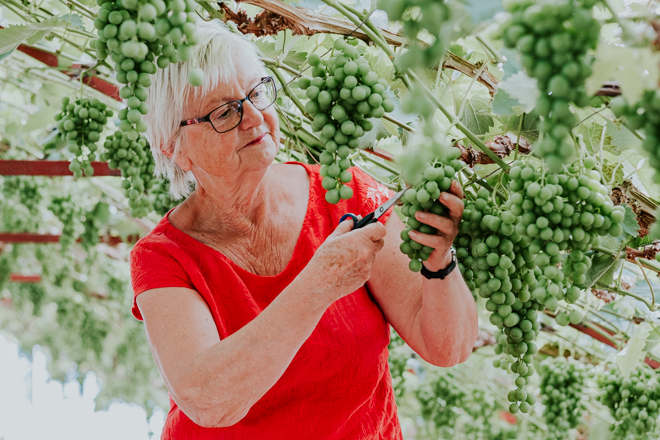- Daily & Weekly newsletters
- Buy & download The Bulletin
- Comment on our articles
Sample grapes during harvest time in Flemish Brabant’s famous region
In 1865, agriculturalist Felix Sohie – who had worked among castle gardens of the Belgian aristocracy – built a greenhouse to grow table grapes in Hoeilaart. And the rest, as they say, is history.
More than 150 years later, this part of the green belt to the south and east of Brussels is still known as the druivenstreek, or grape region. The grapes here have been awarded the EU’s Protected Designation of Origin label, which indicates products with a strong link to the place in which they are made.
Famed among Belgians for its rows of family-owned greenhouses, the grape region encompasses Hoeilaart, Overijse, Huldenberg and Tervuren. One of those family-owned growers is Druiven Mia Michiels. Situated in Hoeilaart, where it all began, Druiven Mia Michiels specialises in the Royal grape (pictured above), plump and purple as it hangs heavy from the vine.
The success of the grape in a region not known for its warm climate might have to do with the Sonian Forest, says Peter Schneider, son of Mia Michiels and the fourth generation to cultivate table grapes on this land. “The forest surrounds us and protects us from the elements,” he says. “We have a bit of a micro-climate.”
 Mia Michiels with her Royals, which are green before they ripen
Mia Michiels with her Royals, which are green before they ripen
Still, like any producer of the Royal, the Michiels vineyard relies on greenhouses to keep the atmosphere temperate. There are about half a dozen kinds of table grapes grown in the grape region, but the Royal is a popular one. “It’s plump and has a soft skin, very sweet and juicy,” says Schneider.
At 39, he says he is possibly the youngest person working in the region’s grape industry. While it used to be a booming sector, “most vineyards required heating, and in the 1960s the energy prices shot up,” he explains. This coincided with the founding of the EEC, which saw an increase in cheaper imports of fresh produce.
“Grapes are also really labour intensive, and costs are high,” continues Schneider. “So parents began to encourage their children to find other careers.”
But there might be a change in the air: “Twenty years ago it was actually more difficult than it is now,” reveals Schneider. “Now people are more interested in ecological products. We are entirely organic and work without heating in the winter. More and more people are concerned about the environment and also with healthy eating. So right now, it’s going really well.”
 Cycle routes wind visitors among the famous vineyards
Cycle routes wind visitors among the famous vineyards
But Druiven Mia Michiels does not live on table grapes alone; the family also grows wine grapes, and Schneider makes gin from grape pulp. Sold in the company’s shop, it’s called Felix Gin, named after Hoeilaart’s first grape grower.
As with most of the small table grape growers in the region, visitors can get free tours at Druiven Mia Michiels and pop into its shop for grapes and related products. The company only sells its table grapes in the shop, and there’s no better time to visit than now because it’s harvest time. “We pluck them as we sell them, so all the grapes are fresh off the vine.”
There are many table grape growers in this part of Flemish Brabant offering tours and tastings in English. In Overijse, for instance, the Vanderkelen family will snip three different kinds of grapes from the vine for you to taste, while in Tervuren, Michel Dekerk grows peaches alongside his Leopold variety of grapes. Flemish Brabant’s website also shows you the way to themed walks and cycle routes in the grape region, easily accessible from Brussels.
Photos courtesy Druiven Mia Michiels and Tourism Flemish Brabant














